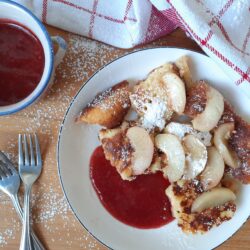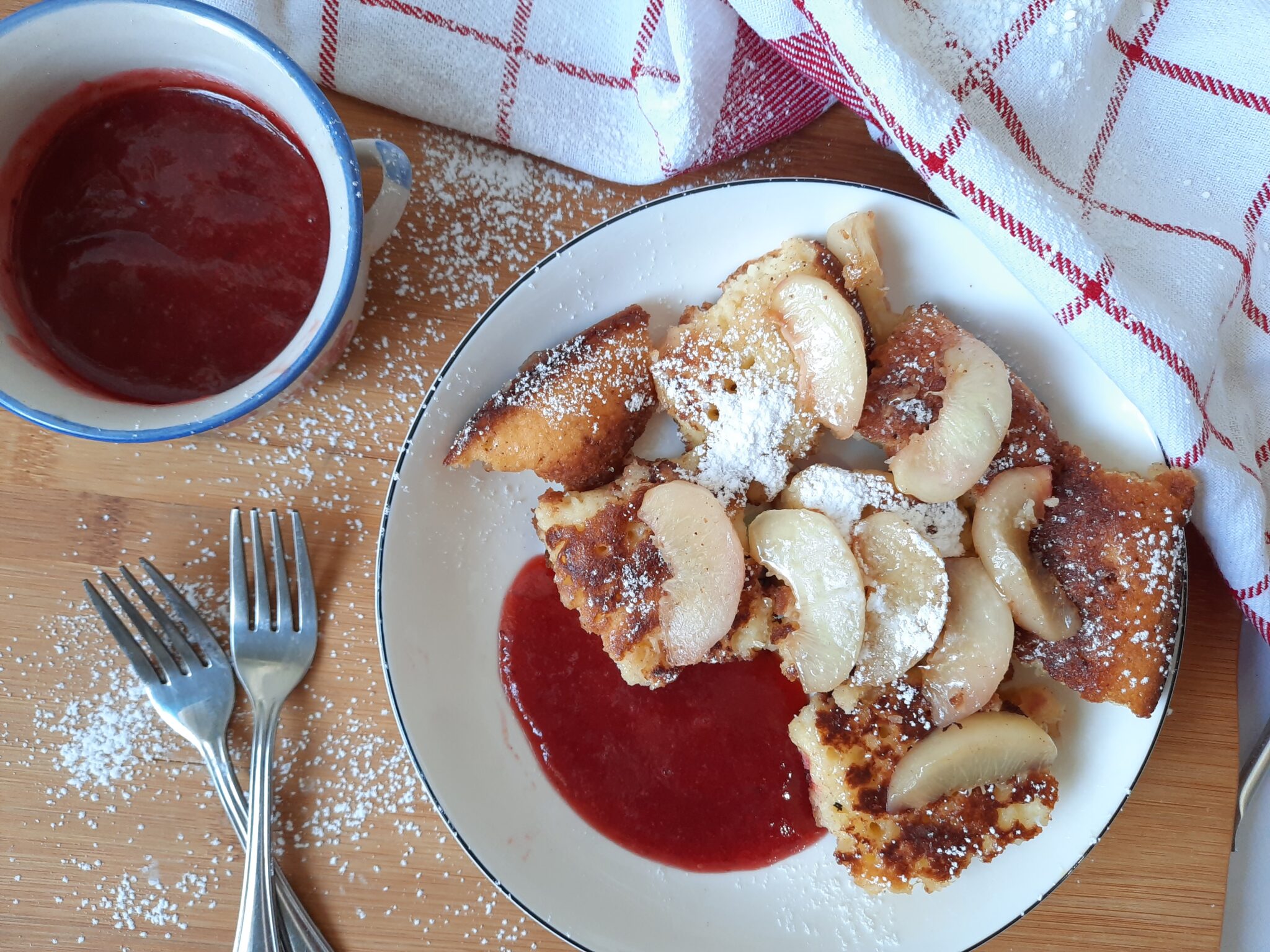Kaiserschmarrn or Kaiserschmarren, also known as Emperor’s Mess, scrambled pancake, shredded pancake, is one of the most popular desserts in Austria. It’s a lightly sweetened pancake that takes its name from the Austrian emperor (Kaiser) Franz Joseph I, who was very fond of this kind of fluffy shredded pancake. The pancake is split into pieces while frying, sprinkled with powdered sugar, and served hot with plum sauce on the side or on top.
Origin and history
Various stories and legends surround the origins of the dish. The name Kaiserschmarren is a compound of the words Kaiser (emperor) and Schmarren (a scrambled or shredded dish).
It is generally agreed that the dish was first prepared for the Austrian Emperor Franz Joseph I (1830–1916). One story of the origin of this dish involves the Emperor and his wife, Elisabeth of Bavaria, of the House of Wittelsbach. Obsessed with maintaining a minimal waistline, Empress Elisabeth directed the royal chef to prepare only light desserts for her, much to the consternation and annoyance of her husband. Upon being presented with the chef’s confection, she found it too rich and refused to eat it. The exasperated Franz Joseph quipped, “Now let me see what ‘Schmarrn’ our chef has cooked up”. It apparently met his approval as he finished his and even his wife’s serving. Thereafter, the dessert was called Kaiserschmarrn across the Empire. According to this lore, Kaiserschmarrn means something along the lines of “emperor’s mess.”
Another legend says that Emperor Franz Joseph I liked to have pastries for dessert, especially Palatschinken (an Austrian version of the French crêpe). If the King’s chef prepared them wrong, for instance, if they were too thick or broken, they were served to the staff, because the Emperor would not eat them. (In this case, Kaiserschmarrn would mean, “Nonsense to serve this to the Emperor.”)
Another popular tale is that his wife was a poor cook and couldn’t flip a pancake efficiently. She decided to play to her strengths and shred the pancakes altogether and would serve them up to the Kaiser on a regular basis with jam. He liked them with jam. It was his favorite dessert.
Tips and notes
- Separating the egg yolk from the whites, then incorporating the beaten egg whites into the batter is the most important part of the recipe. Be careful not to let any of the egg yolks get into the whites.
- To have a fluffy pancake, try to keep the volume when folding in the beaten egg whites.
- Often, you will find some raisins in Kaiserschmarrn, but we prefer this dish without. Feel free to add some, if you like. The traditional way is to soak them in brown rum for a while before adding them to the batter.
- You can add 1 teaspoon vanilla sugar or ½ teaspoon vanilla extract if desired.
- For easily flipping the pancake, you can divide the Kaiserschmarrn into four pieces and flip them separately since the middle doesn’t get completely hard. If it did, the bottom would burn. Once it is flipped, it can cook more slowly.
Serving
Traditionally, Kaiserschmarrn is accompanied by Zwetschgenröster, a fruit compote made with plums. However, you can serve it along with any fresh fruit or compote in season. Apple sauce is also often served with it.
Variants
- Äpfelschmarrn ;
- Semmelschmarrn ;
- Grießschmarrn ;
- Kartoffelschmarrn ;
- Erdäpfelschmarrn ;
- Kirschschmarren ;
- Pancakes ;
- Crêpes ;
- Baghrir ;
- …

Kaiserschmarrn Recipe
Ingredients
- 60 g butter (4tbsp)
- 50 g granulated sugar (¼cup)
- 3 peaches (firm)
- 15 ml lemon juice (1tbsp)
- 120 g flour (1cup)
- 250 ml milk (1cup)
- 2 g lemon zest (1tsp)
- 4 eggs
- 1 pinch salt
- 45 g confectioners' sugar (⅓cup)
Instructions
- Peal and quarter the peaches about ¼in (0.5cm) thick.
- In a skillet, melt ½ tbsp of butter with 1 tbsp of granulated sugar, the lemon juice and the peaches quarter's.
- Cook over high heat for about 5 minutes stirring continuously. Then, transfer to a plate.
- In a large bowl whisk the eggs' yolk, the milk, the flour, 2 tbsp of granulated sugar and the lemon zest.
- In another bowl, beat the eggs whites with a pinch of salt. Then, add 1 tbsp of granulated sugar.
- fold the eggs whites into the previous butter.
- In a skillet, melt 1 tbsp of butter, add the prepared batter, cover and cook over low heat for about 4-5 minutes.
- Slide the pancake into a plate and cook the other side for 2-3 minutes.
- With a maryse cut the pancake into 2in (4 cm) squares .
- Add 2 tbsp and ½ melted butter and the confectioners' sugar. Top it with the peaches and cook for another 5 minutes.
- Serve with a fruit compote, applesauce or jam.








































Sources: 1. Kaiserschmarrn. https://en.wikipedia.org/wiki/Kaiserschmarrn 2. Melanie De Proft (1956). The German and Viennese cookbook. Book Production Industries, Inc. Page 60.




